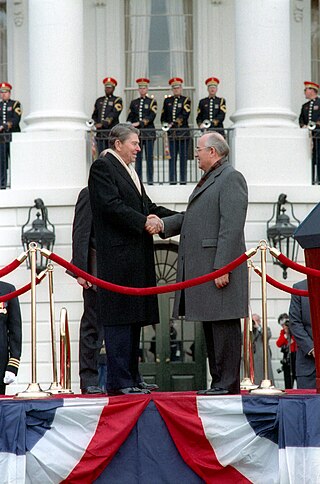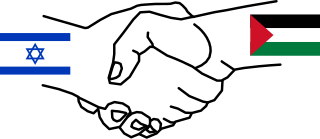External links
- "Track II (Citizen) Diplomacy" at The Beyond Intractability Knowledge Base Project
- Institute for Multi-Track Diplomacy
| Roles |
| ||||||||||||||||
|---|---|---|---|---|---|---|---|---|---|---|---|---|---|---|---|---|---|
| Offices | |||||||||||||||||
| Types | |||||||||||||||||
| Topics | |||||||||||||||||
| Documents | |||||||||||||||||
| Other topics | |||||||||||||||||
| Authority control databases: National |
|---|
Track II diplomacy is the practice of "non-governmental, informal and unofficial contacts and activities between private citizens or groups of individuals, sometimes called 'non-state actors.' " [1] It contrasts with track I diplomacy, which is official, governmental diplomacy that occurs inside official government channels. [2] However, track two diplomacy is not a substitute replacement for track one diplomacy. Rather, it is there to assist official actors to manage and resolve conflicts by exploring possible solutions derived from the public view and without the requirements of formal negotiation or bargaining for advantage. [3] In addition, the term track 1.5 diplomacy is used by some analysts to define a situation where official and non-official actors cooperate in conflict resolution. [4]
In 1981, Joseph V. Montville, then a U.S. State Department employee, coined the phrases track one and track two diplomacy in "Foreign Policy According to Freud," which appeared in Foreign Policy. Track one diplomacy was what diplomats did—formal negotiations between nations conducted by professional diplomats. Track two diplomacy referred to conflict resolution efforts by professional non-governmental conflict resolution practitioners and theorists. "Track two has as its object the reduction or resolution of conflict, within a country or between countries, by lowering the anger or tension or fear that exists, through improved communication and a better understanding of each other's point of view." [5]
The efforts of these conflict resolution professionals, generally operating through non-governmental organizations (NGOs) and universities, arose from the realization by diplomats and others that formal official government-to-government interactions were not necessarily the most effective methods for securing international cooperation or resolving differences.
Track two diplomacy is unofficial, non-structured interaction. It is always open minded, often altruistic, and ... strategically optimistic, based on best case analysis. Its underlying assumption is that actual or potential conflict can be resolved or eased by appealing to common human capabilities to respond to good will and reasonableness. Scientific and cultural exchanges are examples of track two diplomacy. The problem most political liberals fail to recognize is that reasonable and altruistic interaction with foreign countries cannot be an alternative to traditional track one diplomacy, with its official posturing and its underlying threat of the use of force. Both tracks are necessary for psychological reasons and both need each other. [6]
Montville (Davidson & Montville, 1981) maintains that there are two basic processes in track two diplomacy. The first consists of facilitated workshops that bring members of conflicting groups together to develop personal relationships, understand the conflict from the perspective of others, and develop joint strategies for solving the conflict. The second process involves working to shift public opinion: "Here the task is a psychological one which consists of reducing the sense of victim hood of the parties and rehumanizing the image of the adversary." [7]
Montville emphasized that Track Two Diplomacy is not a substitute for Track One Diplomacy, but compensates for the constraints imposed on leaders by their people's psychological expectations. Most important, Track Two Diplomacy is intended to provide a bridge or complement official Track One negotiations. [8]
Methods for conducting these activities are still evolving as is the thinking around which individuals—representing various roles and functions in society and government—should be included. Montville points out that "there is no evidence that conflict resolution workshops would work for the principal political leaders themselves—perhaps because they are too tough or even impervious to the humanizing process." [9] John McDonald (Sep 2003–Aug 2004) seconds this assumption but feels that it is merely because the leaders are stuck in rigid roles and politically have less access to fluidity than individuals further removed from the top echelon of government (McDonald, Sep 2003–Aug 2004).
In 1986 John McDonald and Diane Bendahmane (1987) produced Conflict Resolution: Track Two Diplomacy, a book that compiled the thoughts of several Track One and Track Two professionals confirming the need for government to support, encourage, and work with Track Two. The Department of State refused to print the book for eighteen months because the Department has a strong defensiveness regarding its right, ability, and authority to conduct conflict resolution. The book was finally published in 1987 and states that
The official government apparatus for analyzing international security issues and designing foreign policy has to equip itself to support and benefit from track two diplomacy. As part of the process, government analysts must improve their capabilities to understand how history, society, culture, and psychology interact. [10]
At a special briefing for representatives of non-governmental organizations, the U.S. Department of State's Deputy Director for Political Affairs in the Office of Iraq presented a plea for help from NGOs (Paul Sutphin, 2004). Acting under Secretary Colin Powell's initiative and authority, the State Department's Iraqi analysts explained their frustrations in conducting dialogue, developing grassroots relationships, and rebuilding infrastructure. Far from admitting that the State Department was limited in its right, ability, and authority to conduct conflict resolution, they admitted that they couldn't build relationships or spend money fast enough to rebuild Iraq in time to appease the Iraqis and needed help to do it. This may not be the ideal situation in terms of NGO and State Department cooperation.
"Further Exploration of Track Two Diplomacy" was published in 1991 as an Occasional Paper (McDonald), and as a chapter in Timing the De-Escalation of International Conflicts (Kriesberg & Thorson, 1991). Moreover, in the same year, "The Arrow and the Olive Branch," which was written as an article in The Psychodynamics of International Relations, Montville adds the third process in track two diplomacy. Aside from previous two processes of facilitating small workshops and influencing public opinion, he claims that the third process is cooperative economic development. Although it may not seem essential to conflict resolution, it is meaningful in the sense that it provides incentives, institutional support, and continuity to the political and psychological processes. [11]
In 1996 Dr. Louise Diamond and John McDonald published Multi-Track Diplomacy: A Systems Approach to Peace. Since then the model has been more robustly developed and the original second track has been expanded into nine tracks: peacemaking through diplomacy, conflict resolution, commerce, personal involvement, learning, advocacy, religion, funding, information. [12]
One of the successful track two dialogue processes can be the Oslo Accords of 1993 between Israel and the Palestine Liberation Organization (PLO), which achieved some remarkable breakthroughs in the Israeli–Palestinian relationship. The contacts began as a track two diplomacy, with an unofficial initiative by a Norwegian scholar, but had transitioned into track one diplomacy by the time it was finished, finalized with a handshake between Israeli Prime Minister Yitzhak Rabin and PLO head Yasser Arafat on the White House lawn. [13]
Another example can be the sustained Jewish-Palestinian Living Room Dialogue Group which begun in 1992. From 2003 to 2007 it partnered with Camp Tawonga to bring hundreds of adults and youth from 50 different towns in Palestine and Israel to successfully live and communicate together at the Palestinian-Jewish Family Peacemakers Camp—Oseh Shalom – Sanea al-Salam. [14]

Foreign policy, also known as external policy, is the set of strategies and actions a state employs in its interactions with other states, unions, and international entities. It encompasses a wide range of objectives, including defense and security, economic benefits, and humanitarian assistance. The formulation of foreign policy is influenced by various factors such as domestic considerations, the behavior of other states, and geopolitical strategies. Historically, the practice of foreign policy has evolved from managing short-term crises to addressing long-term international relations, with diplomatic corps playing a crucial role in its development.

The United States Institute of Peace (USIP) is an American federal institution tasked with promoting conflict resolution and prevention worldwide. It provides research, analysis, and training to individuals in diplomacy, mediation, and other peace-building measures.
Civil Affairs (CA) is a term used by both the United Nations and by military institutions, but for different purposes in each case.

Donald Franchot McHenry is a former American diplomat. He was the United States Ambassador and Permanent Representative to the United Nations from September 1979 until January 20, 1981.

Richard Nathan Haass is an American diplomat. He was president of the Council on Foreign Relations from July 2003 to June 2023, prior to which he was director of policy planning for the United States Department of State and a close advisor to Secretary of State Colin Powell in the George W. Bush administration. In October 2022, Haass announced he would be departing from his position at CFR in June 2023. He was succeeded by former U.S. trade representative Michael Froman.
Peace journalism is a style and theory of reporting that aims to treat stories about war and conflict with balance, in contrast to war journalism, which peace journalism advocates say display a bias toward violence. The theory proposes practical methods for correcting biases in stories appearing in the mainstream and alternative media, and suggests ways for journalists to work with other media professionals, audiences, and organizations in conflict.

Carey Edward Cavanaugh is a former U.S. Ambassador/peace mediator and chairman of International Alert, a London-based independent peacebuilding organization. He is currently professor of diplomacy at the University of Kentucky.
The foreign policy of the Bill Clinton administration was of secondary concern to a president fixed on domestic policy. He relied chiefly on his two experienced Secretaries of State Warren Christopher (1993–1997) and Madeleine Albright (1997–2001), as well as Vice President Al Gore. The Cold War had ended and the Dissolution of the Soviet Union had taken place under his predecessor President George H. W. Bush, whom Clinton criticized for being too preoccupied with foreign affairs. The United States was the only remaining superpower, with a military strength far overshadowing the rest of the world. There were tensions with countries such as Iran and North Korea, but no visible threats. Clinton's main priority was always domestic affairs, especially economics. Foreign-policy was chiefly of interest to him in terms of promoting American trade. His administration signed more than 300 bilateral trade agreements. His emergencies had to do with humanitarian crises which raised the issue of American or NATO or United Nations interventions to protect civilians, or armed humanitarian intervention, as the result of civil war, state collapse, or oppressive governments.

Egypt and the United States formally began relations in 1922 after Egypt gained nominal independence from the United Kingdom. Relations between both countries have largely been dictated by regional issues in the Middle East such as the Israeli–Palestinian conflict and Counterterrorism. But also domestic issues in Egypt regarding the country's human rights record and American support for the regimes of Hosni Mubarak and Abdel Fattah el-Sisi which the United States had come under controversy for in the aftermath of the 2011 Egyptian Revolution, and with many dissents of the current regime describing Sisi's rule as tyrannical.
The Geneva Peace Conference was held on January 9, 1991, in Geneva, Switzerland, to find a peaceful solution to the Iraqi occupation of Kuwait in order to avoid a war between Ba'athist Iraq and the United States-backed coalition. Iraqi Foreign Minister Tariq Aziz represented Iraq, while U.S. Secretary of State James Baker was the United States representative. Lasting nearly seven hours, both parties refused to move on their initial positions. Iraq refused to withdraw from Kuwait, while the United States and its allies continued to demand Iraq's immediate withdrawal. The meeting was the final initiative that eventually led to the Gulf War.
Peacemakers are individuals and organizations involved in peacemaking, often in countries affected by war, violent conflict, and political instability. They engage in processes such as negotiation, mediation, conciliation, and arbitration—drawing on international law and norms.

Diplomacy comprises spoken or written communication by representatives of state, intergovernmental, or nongovernmental institutions intended to influence events in the international system.
The United States foreign policy during the presidency of John F. Kennedy from 1961 to 1963 included diplomatic and military initiatives in Western Europe, Southeast Asia, and Latin America, all conducted amid considerable Cold War tensions with the Soviet Union and its satellite states in Eastern Europe. Kennedy deployed a new generation of foreign policy experts, dubbed "the best and the brightest". In his inaugural address Kennedy encapsulated his Cold War stance: "Let us never negotiate out of fear. But let us never fear to negotiate".

Full spectrum diplomacy is a combination of traditional, government-to-government diplomacy with the many components of public diplomacy as well as the integration of these two functions with other instruments of statecraft. The term was coined by John Lenczowski, founder and president of The Institute of World Politics in Washington, D.C. in his book Full Spectrum Diplomacy and Grand Strategy: Reforming the Structure and Culture of U.S. Foreign Policy which was released in May, 2011.
The Interagency Active Measures Working Group was a group led by the United States Department of State and later by the United States Information Agency (USIA). The group was formed early during the Reagan administration, in 1981, purportedly as an effort to counter Soviet disinformation.
Global Peace System is a concept of global conflict resolution dependent on nonviolent processes to eradicate war. It relies upon a multi-strand approach to conflict resolution, incorporating broad social and political solutions. In contemporary peace and conflict studies, the concept of a global peace system has been evolving since the 1940s around the theory that there is a global infrastructure of peacebuilding and that there is a need for systems thinking in peacebuilding. The term "global peace system" was coined from the work of Robert Johansen, who explored the concept in 1978's Toward a Dependable Place.

The Madrid Conference of 1991 was a peace conference, held from 30 October to 1 November 1991 in Madrid, hosted by Spain and co-sponsored by the United States and the Soviet Union. It was an attempt by the international community to revive the Israeli–Palestinian peace process through negotiations, involving Israel and the Palestinians as well as Arab countries, including Jordan, Lebanon and Syria.
Peace psychology is a subfield of psychology and peace research that deals with the psychological aspects of peace, conflict, violence, and war. Peace psychology can be characterized by four interconnected pillars: (1) research, (2) education, (3) practice, and (4) advocacy. The first pillar, research, is documented most extensively in this article.
Randa Slim is a Lebanese-American foreign-policy professional specializing in Track II diplomacy.

John Warlick McDonald was an American diplomat. He was appointed to the rank of ambassador twice by Jimmy Carter and twice by Ronald Reagan to represent the United States at United Nations World Conferences. From 1974 to 1978, he was the deputy director general of the International Labour Organization.